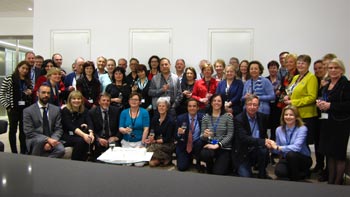15 Years of EU Orphan Medicines Regulation: The Next Chapter

The EU Regulation on Orphan Medicinal Products was implemented 15 years ago. The Regulation established a centralised EU procedure for the designation of orphan medicines and puts in place incentives for companies to carry out research, development and marketing of orphan medicines. These are needed because orphan medicines are not as profitable as medicines that can be used by wider patient populations. Since 2000, 1469 orphan designations and 103 marketing authorisations have been granted.
The Committee for Orphan Medicinal Products (COMP), also celebrating its 15th anniversary this year, was born out of this Regulation. EURORDIS volunteers currently hold two out of the three patient representative positions on the Committee, Birthe Byskov Holm and Lesley Greene, who holds the post of Committee Vice-Chair.

The Regulation has been successful in stimulating research and development of medicines for rare diseases and in attracting investment from pharmaceutical companies to bring these medicines to market, as demonstrated by the large number of designations and authorisations.
However, there is still work to be done to translate the progress that has been made as a result of the Regulation into to real access to medicines for patients; even if the main incentive of EU market exclusivity is provided to companies, the authority to make all decisions that are taken after marketing authorisation (on health technology assessment and medicines pricing, for example) lies at national level. The gap between decisions taken at a European level and those taken at a national level prevents the establishment of a true single European market for medicines and undermines access for patients. The absence of such a market leads to inefficiencies for manufacturers, patients and national healthcare systems.
EURORDIS, representing the voice of an estimated 30 million Europeans living with a rare disease, believes that we need a smarter Europe, one that ensures better access to orphan medicines. This can be achieved by:
- Strengthening cooperation between Member States through a structured European mechanism supported by the EU Commission, as is already in progress in the area of health technology assessment through EUnetHTA, and also by encouraging alignment of strategies on pricing and market access between Member States. Such cooperation could support the development of an EU single market for specialised pharmaceutical products such as orphan medicines.
- Changing attitudes to risk: The risk-benefit assessment of a medicine should be more flexible by accepting more limited efficacy data and should follow a more adaptive pathway to patients. When assessing the risks and benefits of a new medicine, only patients, as experts of their disease, can legitimately determine how much uncertainty they are willing to accept in exchange for the proposed safety and benefit of a medicine. Rare disease patients, who often don’t have access to a satisfactory medicine or any treatment at all, may be willing to accept more risk than patients who live with diseases for which satisfactory treatments already exist.
- Ensuring that patients have a role in steering industry towards those areas where they need new therapeutic options that can provide a cure or stabilise a disease, in particular areas of unmet medical needs. We need to create conditions to stimulate interest in these areas; the Regulation established incentives for companies to develop and invest in orphan medicines. More incentives (for example, market exclusivity extensions, vouchers or price premium) are now needed to attract companies to unchartered disease areas.
Eva Bearryman, Junior Communications Manager, EURORDIS
